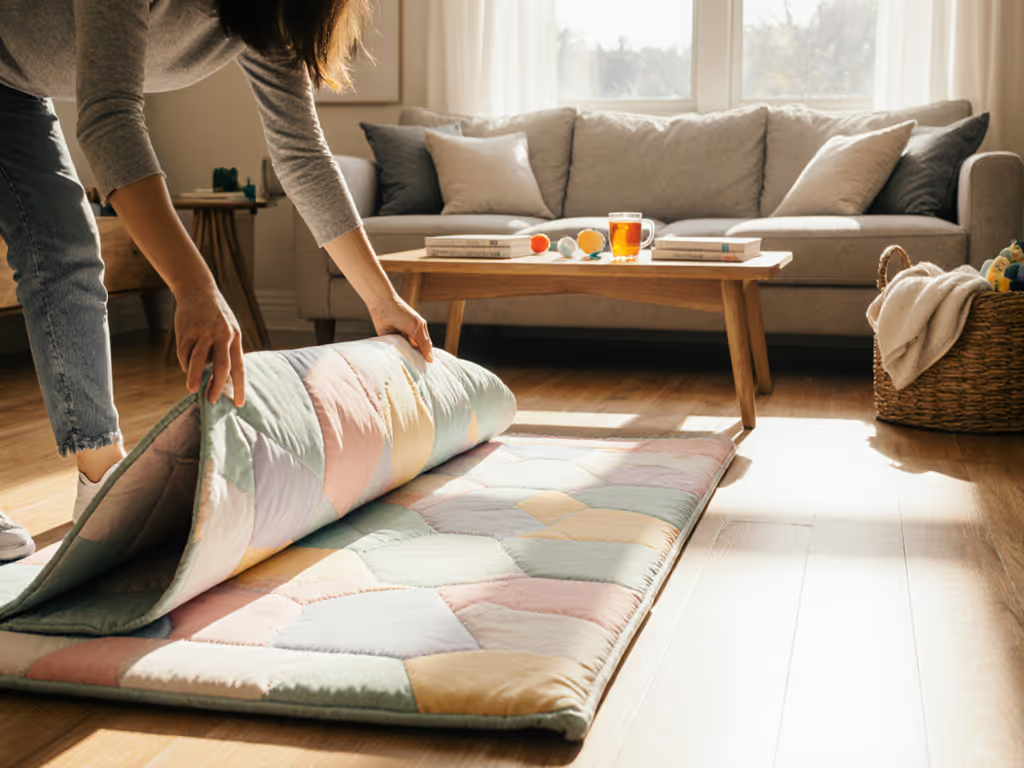
Guide to Baby Play Mats: Choose, Set Up, and Ensure Safety
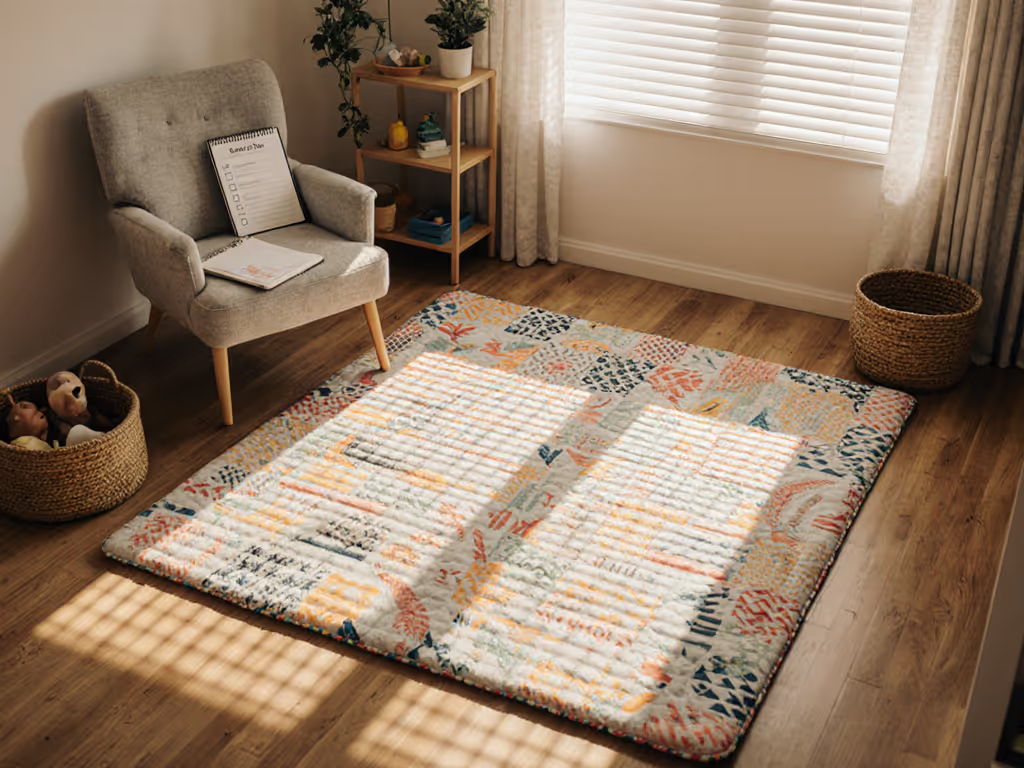
Did you know that babies spend more than 80 percent of their waking hours playing on the floor during early development? Setting up a safe and supportive play space matters because the right play mat shields your child from injury and encourages healthy movement. From avoiding hidden household hazards to picking easy-to-clean materials, making thoughtful choices now creates a foundation for confident crawling, steady first steps, and joyful discovery at every stage.
Quick Summary
| Key Point | Explanation |
|---|---|
| 1. Assess your play space carefully | Measure your play area, noting dimensions and surface types to select the right mat for your needs. |
| 2. Choose safe and durable materials | Look for non-toxic, durable materials that resist wear and tear while being easy to clean, ensuring safety for your baby. |
| 3. Select a suitable design for development | Opt for designs that stimulate sensory exploration through contrasting colors and textures to support your baby's growth stages. |
| 4. Install the mat securely | Ensure proper installation by cleaning the area, positioning it safely away from hazards, and checking its stability regularly. |
| 5. Maintain the mat regularly | Establish a cleaning routine and inspect for wear and tear, ensuring the mat remains a safe environment for your child. |
Step 1: Assess your family's play space and specific needs
Choosing the right play mat starts with understanding your unique home environment and your child's developmental stage. This assessment helps you select a play surface that matches your space constraints and supports your little one's growth.
Start by measuring the actual floor area where your baby will play. Pull out a tape measure and note down precise dimensions. Are you working with a carpeted living room corner? A hardwood kitchen area? A dedicated nursery space? Each surface type impacts your play mat selection.
Consider your child's current and upcoming developmental milestones. Newborns need flat stable surfaces for initial rolling and tummy time. Crawling babies require more textured areas for grip. Emerging toddlers need space for tentative first steps and playful movement.
Take a critical look at potential hazards in your play zone. Check for sharp furniture edges, electrical outlets, or unstable items that might pose risks. Research shows parents who proactively modify play spaces reduce childhood injury potential significantly.
Pro Tip: Create a simple sketch of your play area. Mark potential obstacles and note surface texture to help guide your play mat selection.
Think about your cleaning and maintenance preferences. Some play mat materials wash easily while others require more specialized care. Your lifestyle and time availability matter when choosing a surface that can handle daily baby interactions.
The next step involves comparing your space assessment with specific play mat options that align with your unique requirements.
Step 2: Evaluate materials for safety and durability
Navigating the world of play mat materials feels like decoding a complex puzzle. Your goal is simple identify a surface that keeps your baby safe comfortable and ready for exploration.
Research reveals startling insights about play mat materials. A comprehensive study found that 30% of foam play mats could potentially detach small parts creating unexpected choking risks.
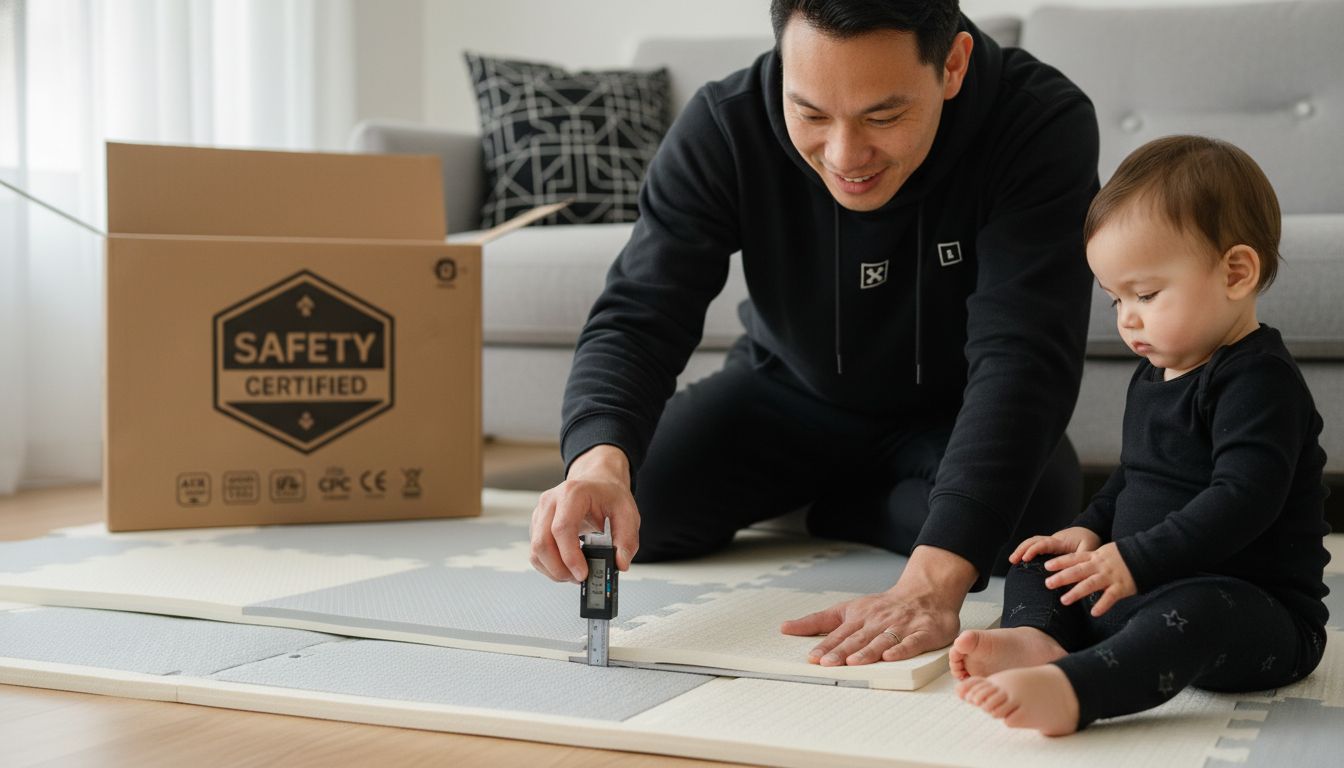 This means you cannot afford to choose materials casually.
This means you cannot afford to choose materials casually.
XPE foam emerges as a standout material for baby play zones. Non toxic and antibacterial this material offers exceptional durability. While slightly more expensive than alternatives it provides peace of mind every parent craves. Look for certifications that confirm material safety standards particularly those meeting international child product regulations.
Consider material characteristics beyond basic safety. Texture matters for developing motor skills. Soft surfaces support initial movements while providing cushioning against accidental tumbles. Water resistance becomes crucial for easy cleaning especially during messy baby stages.
Pro Tip: Always perform a squeeze test. Quality play mat materials should return to original shape quickly without permanent indentation.
Material thickness plays a significant role in protection. Thicker mats absorb more impact reducing potential injury risks during active play. Aim for materials between 10 to 15 millimeters thick to provide optimal cushioning without compromising stability.
Remember that material selection is not just about immediate needs but anticipating future developmental stages. A versatile play mat will grow with your child supporting everything from tummy time to toddler tumbling.
Your next step involves comparing specific material options and understanding their unique advantages for your family's lifestyle.
Step 3: Compare designs for development and style
Choosing a play mat is more than just picking a pretty pattern. You are selecting a critical developmental tool that will support your baby's sensory exploration and physical growth.
Research highlights the importance of intentional design. Activity play mats with detachable toys and contrasting colors are not just cute accessories they are strategic learning platforms. Look for designs that offer visual stimulation through bold color patterns and interactive elements that encourage reaching grasping and cognitive engagement.
Consider developmental stages when evaluating designs. Newborns benefit from high contrast black and white patterns that support early visual tracking. As babies grow they need mats with varied textures that invite tactile exploration. Some advanced designs feature multiple zones supporting different developmental milestones from tummy time to sitting and crawling.
Style matters too. Modern parents want play mats that complement their home aesthetic. Neutral tones geometric patterns and minimalist designs have become increasingly popular. The goal is finding a mat that feels like a functional piece of home decor rather than just another baby item.
Pro Tip: Choose designs with removable or washable surfaces. Babies are messy and your play mat needs to withstand frequent cleaning without losing its visual appeal.
Portability becomes another critical design consideration. TPU play mats offer exceptional versatility being non toxic durable and easy to transport. This means you can create safe play zones in multiple spaces from living rooms to grandparent visits.
Think about long term value. The best designs grow with your child transforming from infant play surface to toddler activity center. Look for mats with modular components or adaptable features that extend their usefulness.
Your next step involves matching these design insights with your specific family needs and preferences.
Step 4: Install your chosen play mat securely
Your play mat is more than a soft surface its a carefully crafted safety zone for your little explorer. Installing it correctly means creating a secure developmental playground that protects and supports your baby.
Start by thoroughly cleaning the floor area where you plan to place the mat. Sweep or vacuum to remove dust dirt and small particles that could interfere with the mat's grip. A clean surface ensures maximum stability and prevents potential irritants from contacting your baby's skin.
Check your mat's specific installation requirements. Some play mats feature built in anti slip backing designed to minimize movement during active play. Gently unroll the mat and smooth out any wrinkles or air bubbles. Press firmly along edges and center to create a flat uniform surface.
Position the mat away from potential hazards like furniture edges electrical outlets or unstable items. Aim to create a dedicated play zone that provides ample space for movement while minimizing risk of accidental bumps or falls.
Pro Tip: Perform a quick stability test by walking around the mat edges. If you notice any significant shifting or lifting consider using specialized mat grips or adhesive strips for additional security.
Research emphasizes the importance of regular mat inspection. Babies are naturally curious and can quickly discover weak points in materials. Check your play mat frequently for signs of wear tear or potential detachment of components. This proactive approach prevents unexpected choking risks and maintains a safe play environment.
Consider the surrounding environment when installing your play mat. Rooms with consistent temperatures and minimal direct sunlight will help preserve the mat's material integrity. Avoid placing the mat near heating vents or in areas with extreme temperature fluctuations.
Your next step involves creating a comprehensive safety routine that keeps your play mat in top condition and your baby protected.
Step 5: Test and maintain play mat for ongoing safety
Safety doesnt stop after initial installation. Your play mat requires consistent monitoring and care to ensure it remains a secure environment for your baby's exploration and growth.
Research reveals critical insights about play mat maintenance. Consumer studies have identified potential chemical risks in foam materials highlighting the importance of regular inspection. Begin with a comprehensive visual and tactile examination of the entire mat surface looking for signs of wear tear or material degradation.
Establish a weekly cleaning routine tailored to your mat's specific material composition. For most mats a damp cloth works perfectly to remove surface dirt and potential bacteria. Fabric mats might offer machine washable options providing convenient deep cleaning opportunities. Always follow manufacturer guidelines to preserve material integrity and safety features.
Perform regular stress tests on your play mat. Gently press and pull different sections checking for consistent resilience and structural soundness. Watch for any areas that seem unusually soft stretched or showing unexpected wear. These could indicate potential future failure points that might compromise safety.
Pro Tip: Create a maintenance log tracking cleaning dates material condition and any observed changes. This proactive documentation helps you stay ahead of potential safety issues.
Pay special attention to mat edges and connection points. These areas experience more stress during baby play and can develop unexpected weaknesses. Check for any loose threads detaching components or emerging sharp edges that could pose injury risks.
Consider the environmental factors affecting your play mat. Humidity temperature fluctuations and direct sunlight exposure can accelerate material breakdown. Position and store your mat strategically to minimize unnecessary stress on its structure.
Your ongoing commitment to testing and maintaining the play mat transforms it from a simple accessory into a reliable developmental support system for your little one.
Here's a summary comparison of key factors to consider for each play mat selection step:
| Step | What to Assess | Key Considerations |
|---|---|---|
| Space Assessment | Room size<br>Surface type<br>Hazards | Exact dimensions<br>Carpeted or hardwood<br>Childproofing needs |
| Material Evaluation | Safety<br>Durability<br>Texture | Non-toxic certifications<br>Impact absorption<br>Easy cleaning |
| Design Comparison | Visual stimulation<br>Developmental fit<br>Style | High-contrast patterns<br>Modular features<br>Home décor match |
| Installation | Secure placement<br>Hazard avoidance<br>Stability | Anti-slip backing<br>Edge risks<br>Air bubble removal |
| Ongoing Maintenance | Cleanliness<br>Wear & tear<br>Environment | Regular inspections<br>Weekly cleaning<br>Avoid sunlight/heat |
Find the Perfect Play Mat for Your Baby's Safe and Joyful Growth
Choosing the right play mat is more than just picking something soft. As highlighted in our article Guide to Baby Play Mats you know the challenge lies in balancing safety durability and developmental benefits for every stage from newborn rolls to toddler tumbles. It can feel overwhelming to assess materials for toxins evaluate design for sensory stimulation and ensure secure installation without constant worry.
At FloorBloom we understand these concerns deeply. That is why we offer rigorously tested play mats made from non toxic materials designed to support your child through each milestone. With easy to clean textures and thoughtful anti slip features you can create a secure play space anywhere in your home. Don’t wait for uncertainty to grow into risk act now and explore our collection that combines real home guidance with proven safety standards.
Ready to give your baby a beautiful and safe place to grow Explore our full range at FloorBloom today and take the first confident step toward worry free playtime. Make your choice easy with trusted support at every stage.
Frequently Asked Questions
How do I assess my home's play space for a baby play mat?
To assess your play space effectively, measure the area where your baby will play and note the type of flooring, whether it's carpet, hardwood, or another surface. Create a sketch to identify hazards like furniture edges or electrical outlets, ensuring you choose a mat that fits securely in your environment.
What materials should I consider for a safe baby play mat?
Look for materials that are non-toxic and durable; XPE foam is a highly recommended option for its antibacterial properties and resilience. Prioritize mats that meet safety standards and perform a squeeze test to ensure they return to their original shape without permanent indentation.
What design features should I prioritize when choosing a play mat?
Select designs that promote developmental growth, such as mats with high-contrast colors for newborns or varied textures for crawling babies. Ensure the mat includes removable or washable surfaces to maintain cleanliness, allowing you to keep it looking fresh and safe for about 30 days with regular use.
How do I install a baby play mat securely in my home?
Begin by cleaning the floor area thoroughly before placing the mat; this maximizes grip and safety. Check for built-in anti-slip backing, smooth out wrinkles, and test stability by walking on the edges to ensure it remains secure during active play.
What steps should I take for the ongoing maintenance of a baby play mat?
Perform regular inspections of the mat to check for wear and tear, focusing on edges and connection points. Establish a weekly cleaning routine with a damp cloth or follow wash instructions if the mat is machine washable, maintaining its condition for long-lasting use.
Recommended
Related Articles

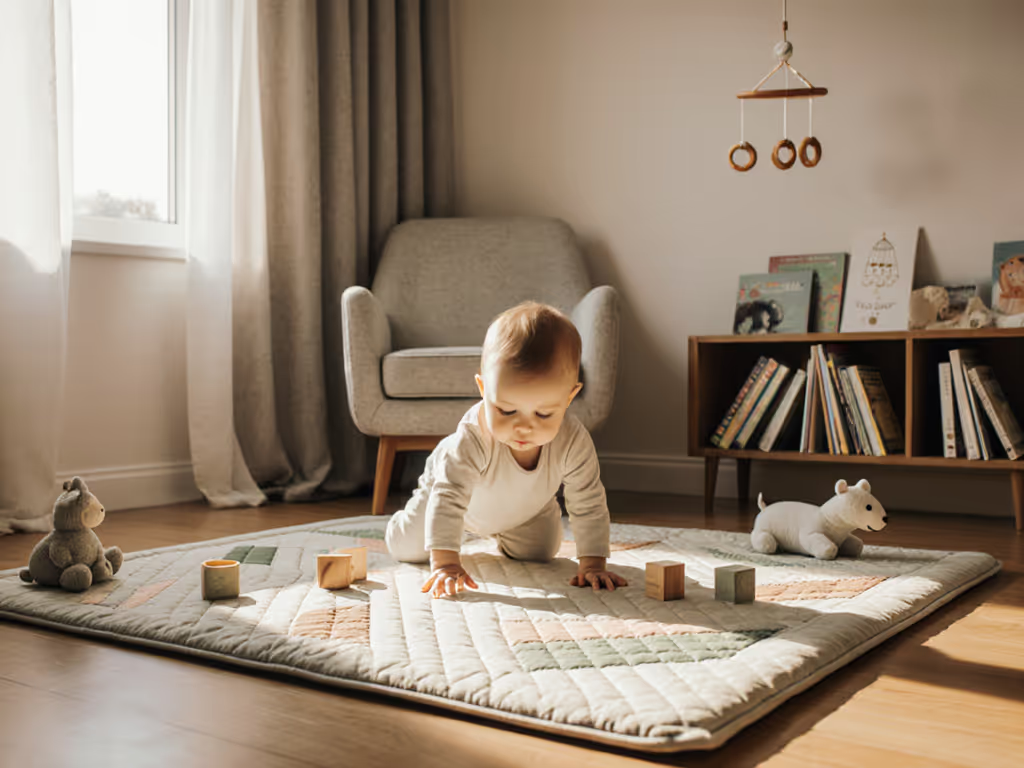
Best Play Mats for Crawling Infants – Expert Comparison 2025
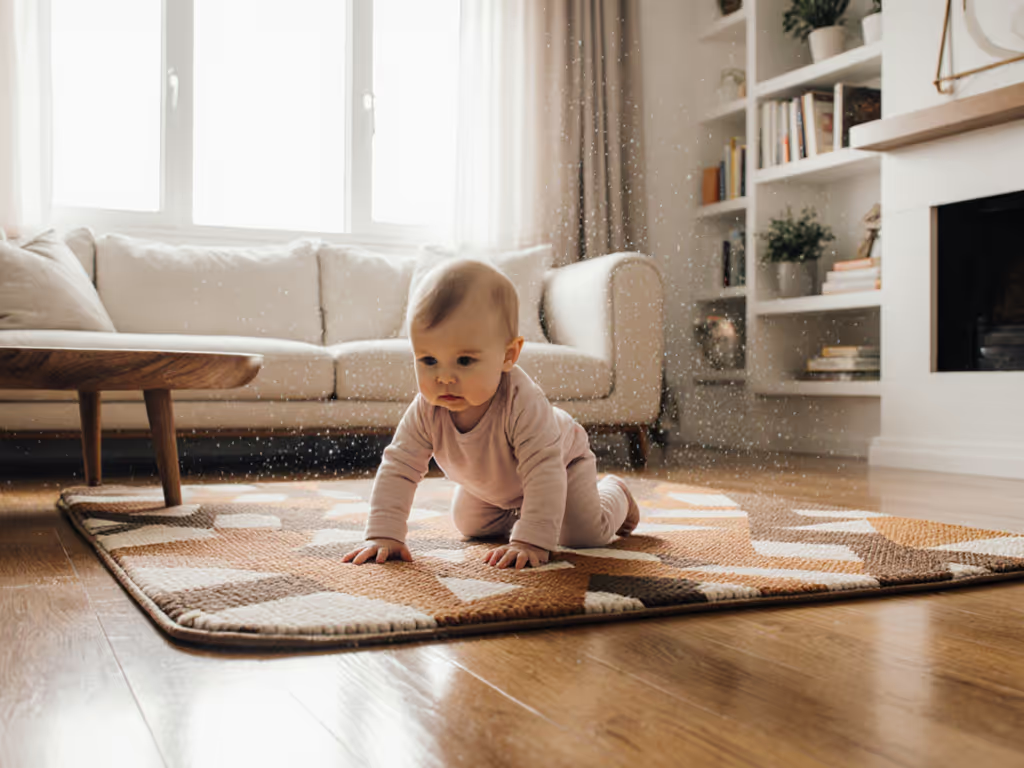
Crawling Mat Explained: Safe Play from Infancy Onward

The Essential Guide to Why Use Play Mats
